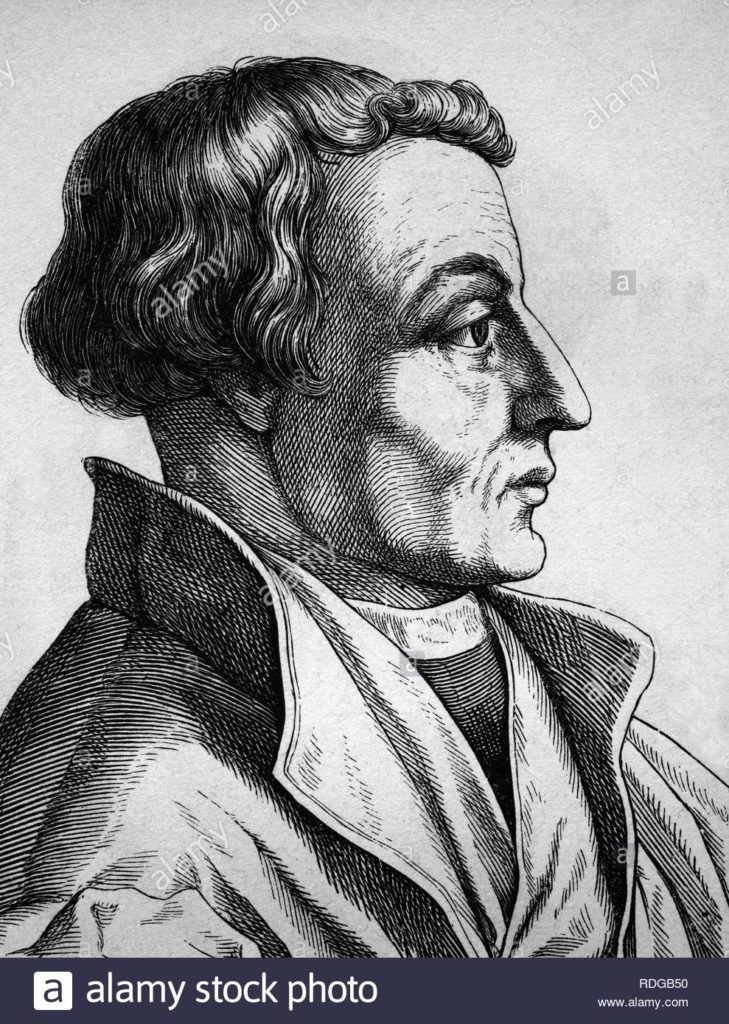Strasbourg, the capital of Alsace, famous for its Gothic cathedral, university and libraries, long before the Reformation, was not the setting for Tauler, mystical preacher of renewal and the “Friends of God”. Strasbourg was a completely German city before Louis XIV incorporated it into France (1681); it was recaptured by Germany in 1870.
The Reformation began in this city in 1523: Zell, Bucer, Capito (Kopfel), Hedio (Heil) and for some years calvin (from 1538 to 1541) worked there with great success. Civil magistrates abolished Mass in 1528, and promoted the Protestant cause under the leadership of Jacob Sturm, a patriot who represented the city in all major local negotiations, in the Diet and in conferences with the Romanists, until his death in 1553. He called for the establishment of a Christian college, where classical teaching and evangelical piety would be cultivated, whose namesake, Johann Sturm, eminent pedagoguus, was called from Paris to preside over this faculty (1537), which became an academy and, finally, a university. She agreed with Capito and Bucer. La church in Strasbourg was very agitated by the peasant war, by the Anabaptists and by sad sacramental controversies.
- The main reformer in Strasbourg was Martin Bucer (1491-1552).
- Originally from Alsace.
- He was a Dominican monk and was later ordained a priest.
- He was deeply marked by Luther in the Heidelberg dispute (1518); he obtained the papal dispensation from his monastic vows (1521); left the Romanesque church; found refuge in the castle of Francis de Sickingen; he married a nun and accepted an appeal to Strasbourg in 1523.
There, he worked as a minister for twenty-five years and participated in many important movements related to the Reformation. He participated in the Marburg Symposium (1529); wrote, with Capito, the tetrapolite Confession (1530); stimulated a formal and short-term agreement between Luther and Zwinglio through the Concorde of Wittenberg (1536); unfortunately, he was complicit in the bigamy of Filipe de Hesse; Melanchthon in Wittenberg, Miconius in Basel and Calvin in Geneva offered him asylum; but he and Fagius accepted a call from Cranmer in England (1549). He helped him with his reforms; He was highly appreciated by the Archbishop and King Edward VI, and completed his work as professor of theology at Cambridge. His bones were exhumed during the reign of Mary, the bloodthirsty (1556), but his memory was duly restored by Queen Elizabeth (1560).
Bucer is regarded as the third (along with Luther and Melanchthon) among the reformers of Germany, as a theologian and diplomat, and above all as a conciliator and peacemaker between Lutherans and Zuinglianos. He also formed a link between Germany and England and exerted some influence in establishing Anglican standards of doctrine and worship. His motto was: “Do we believe in Christ, not in the church?[? Wir sind Christgl-ubig, nicht kirchgl-ubig?].
He imprinted his features on the church in Strasbourg, which occupied common ground between Wittenberg and Zurich, and housed Calvin and the Reformed refugees from France. Strict Lutheranism triumphed for a time, but its eronic catholicity was revived in the practical pietism of Spener, also Alsatian. More recently, the Strasbourg teachers, under the direction of Dr. Reuss, have mediated Protestant theology in Germany and France, in both languages, and have presented the best edition of Joo Calvin’s works.
By: Philip Schaff. © Ethereal Library of Christian Classics. Website: http://www. ccel. org/. Traduit with permission. Source: History of the Christian Church, Volume VII, Modern Christianity. German reform.
Original: History of the Christian Church, Volume VII. Modern Christianity German reform 95 La Reforma in Strasbourg Martin Bucer, © Department of Faithful. Website: MinisterioFiel. com. br All rights are reserved. Translation: Camila Rebeca Teixeira, reviewed by William Teixeira.

